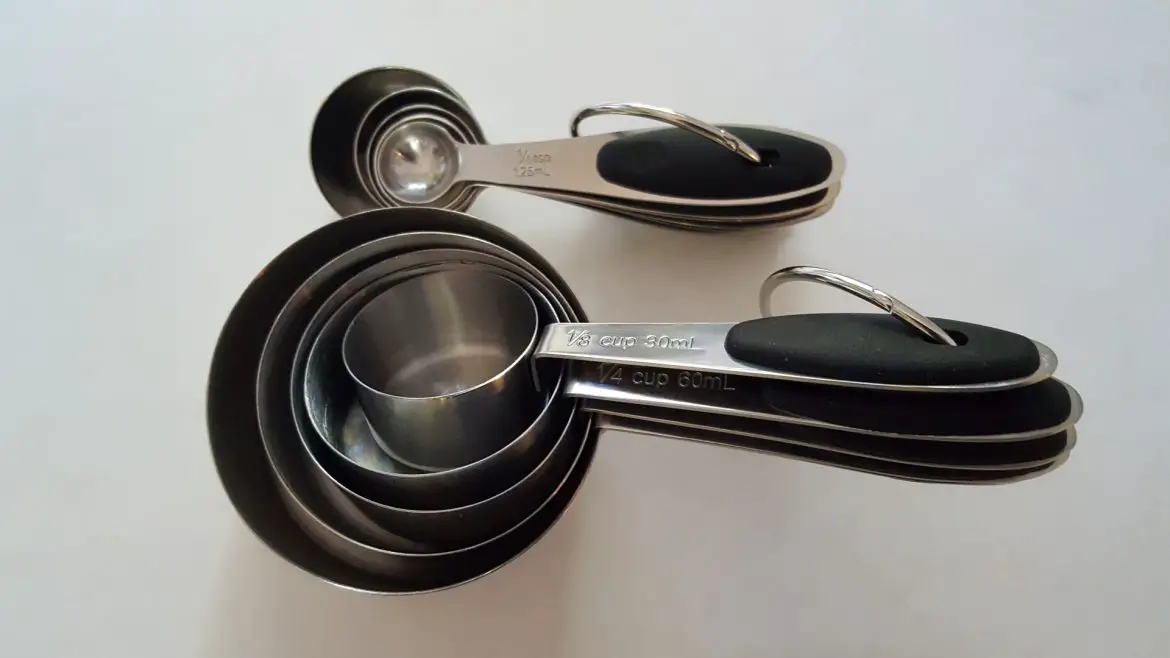When you’re browsing recipes, you often find different types of measurements for the ingredients. Some of them use conventional measuring cups while others use grams. But is there an easy conversion between these measurements? Can you tell exactly how many grams are in a cup?
Most Common Cooking Ingredients
Measuring your ingredient by weight (grams) instead of volume (cups) can yield more consistent results. That’s why we gathered here in this table how many grams there are in one cup of the most common cooking ingredients. Make sure to read the whole article to find out why it is that difficult to tell exactly how much is a cup in grams.
How Many Grams In A Cup
| Ingredient | How Many Grams In 1 Cup |
|---|---|
| Water | 240 g |
| Flour | 125 g |
| Sugar (white, granulated) | 200 g |
| Butter | 227 g |
| Brown sugar | 220 g |
| Powdered sugar | 120 g |
| Honey | 340 g |
| Cocoa powder | 100 g |
How Much Is A Cup In Grams
Unfortunately there is no easy conversion method to tell how many grams are in 1 cup, even if some websites try to sell you on that idea. Let’s understand why these 2 systems are not easy to use interchangeably.
Cups represent a unit of volume (as a quantity of space in an enclosed container) while grams represent a unit of mass. Depending on the density of the substance you want to measure, the answer to the question how many grams in a cup can vary.
Water is the easiest substance to convert to grams from a cup. A US cup is 240 milliliters (ml), and for water you can use an easy 1:1 ml to g ratio. So if your question is about water, there are 240 grams in a cup.
But all other substances have different densities, so the gram value you measure in a cup of each ingredient might be very different. Take cocoa powder and honey as an example. The same cup of these two ingredients means a more than 3 fold difference in gram values.
For this reason, never assume how many grams there are in a cup if you have no exact conversion data for that particular ingredient.
A good idea would be to order a kitchen scale and start using that for cooking. That, along with your measuring cups and spoons, can give you exact values no matter how the recipe is written. And besides food scales are incredibly cheap and easy to use.
Different Cups – Different Gram Values
But we’re still not at the end of the challenges of telling how many grams in a cup.
So far we have assumed that you are using US legal cups, or the recipe is referring to that type of cup. That’s 240 ml, which is used in nutritional labels in the US. But the US customary cup, which is referred to in recipes, is 236.588 ml. Don’t worry though for this one, the difference is so subtle (less than 1.5%) that you can’t go wrong interchanging these.
But there are other cups in use in English recipes, especially if you stumble upon an older one. 1 UK imperial cup (used before 1970) was 284.131 ml, you might find that in recipes before the 1970s. The UK, Australia, New Zealand and Canada uses what’s called a metric cup, which is 250 milliliters. Read this Wikipedia article on cups if you are more deeply interested in this topic and want to find even more cup sizes.
Confused? Don’t be.
Let’s refresh our table showing how many grams there are in 1 cup for the most common cooking ingredients with all these cup units. We are not making a distinction between the two US cup sizes, but use instead the US legal cup, which is generally accepted in cups to grams conversions. Please note that gram values are rounded.
| Ingredient | How Many Grams In 1 US Cup | How Many Grams In 1 Metric Cup | How Many Grams In 1 Imperial Cup |
|---|---|---|---|
| Water | 240 g | 250 g | 284 g |
| Flour | 125 g | 148 g | 175 g |
| Sugar (white, granulated) | 200 g | 237 g | 280 g |
| Butter | 227 g | 269 g | 318 g |
| Brown sugar | 220 g | 260 g | 308 g |
| Powdered sugar | 120 g | 142 g | 168 g |
| Honey | 340 g | 403 g | 477 g |
| Cocoa powder | 100 g | 118 g | 140 g |
The Solution To The How Many Grams In 1 Cup Problem
As we mentioned before, the best solution is to have a set of measuring cups and a food scale at home, and try to weigh your ingredients whenever you can.
Also, for critical recipes (especially dough, such as bread, pizza etc.) find recipes that give you exact gram measurements.
